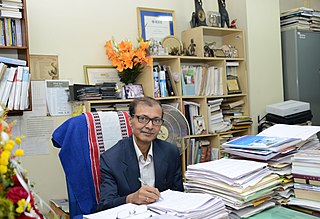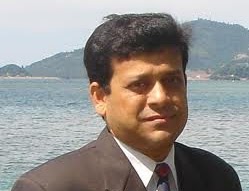Related Research Articles
Robert M. Haralick is Distinguished Professor in Computer Science at Graduate Center of the City University of New York (CUNY). Haralick is one of the leading figures in computer vision, pattern recognition, and image analysis. He is a Fellow of the Institute of Electrical and Electronics Engineers (IEEE) and a Fellow and past president of the International Association for Pattern Recognition. Professor Haralick is the King-Sun Fu Prize winner of 2016, "for contributions in image analysis, including remote sensing, texture analysis, mathematical morphology, consistent labeling, and system performance evaluation".

Thomas Shi-Tao Huang was a Chinese-born American computer scientist, electrical engineer, and writer. He was a researcher and professor emeritus at the University of Illinois at Urbana-Champaign (UIUC). Huang was one of the leading figures in computer vision, pattern recognition and human computer interaction.
Ramesh Chandra Jain is a scientist and entrepreneur in the field of information and computer science. He is a Bren Professor in Information & Computer Sciences, Donald Bren School of Information and Computer Sciences, University of California, Irvine.

Xuedong David Huang is a Chinese American computer scientist and technology executive who has made contributions to spoken language processing and artificial intelligence, including Azure AI Services. He is Zoom's chief technology officer after serving as Microsoft's Technical Fellow and Azure AI Chief Technology Officer for 30 years. Huang is a strong advocate of AI for Accessibility, and AI for Cultural Heritage.
Matti Kalevi Pietikäinen is a computer scientist. He is currently Professor (emer.) in the Center for Machine Vision and Signal Analysis, University of Oulu, Finland. His research interests are in texture-based computer vision, face analysis, affective computing, biometrics, and vision-based perceptual interfaces. He was Director of the Center for Machine Vision Research, and Scientific Director of Infotech Oulu.
Munindar P. Singh is a SAS institute distinguished professor and a full professor in the Department of Computer Science at North Carolina State University. Singh is an IEEE Fellow, a AAAI Fellow, a AAAS Fellow, an ACM Fellow, a Member of Academia Europaea, and a ACM SIGAI Autonomous Agents Research Award recipient.

Anil Kumar Jain is an Indian-American computer scientist and University Distinguished Professor in the Department of Computer Science & Engineering at Michigan State University, known for his contributions in the fields of pattern recognition, computer vision and biometric recognition. He is among the top few most highly cited researchers in computer science and has received various high honors and recognitions from institutions such as ACM, IEEE, AAAS, IAPR, SPIE, the U.S. National Academy of Engineering, the Indian National Academy of Engineering and the Chinese Academy of Sciences.

Bidyut Baran Chaudhuri is a senior computer scientist and the pro-vice-chancellor (academic) of Techno India University in West Bengal, India. He is also adjuncted to Indian Statistical Institute (ISI), where he was a professor for about three decades. He was the founding Head of Computer Vision and Pattern Recognition Unit of ISI. Moreover, he was a J.C. Bose Fellow and INAE Distinguished Professor at ISI.

Shrikanth Narayanan is an Indian-American Professor at the University of Southern California. He is an interdisciplinary engineer–scientist with a focus on human-centered signal processing and machine intelligence with speech and spoken language processing at its core. A prolific award-winning researcher, educator, and inventor, with hundreds of publications and a number of acclaimed patents to his credit, he has pioneered several research areas including in computational speech science, speech and human language technologies, audio, music and multimedia engineering, human sensing and imaging technologies, emotions research and affective computing, behavioral signal processing, and computational media intelligence. His technical contributions cover a range of applications including in defense, security, health, education, media, and the arts. His contributions continue to impact numerous domains including in human health, national defense/intelligence, and the media arts including in using technologies that facilitate awareness and support of diversity and inclusion. His award-winning patents have contributed to the proliferation of speech technologies on the cloud and on mobile devices and in enabling novel emotion-aware artificial intelligence technologies.

Theodosios Pavlidis is a computer scientist and Distinguished Professor Emeritus of Computer Science at the State University of New York, Stony Brook.
Dorin Comaniciu is a Romanian-American computer scientist. He is the Senior Vice President of Artificial Intelligence and Digital Innovation at Siemens Healthcare.

David S. Doermann is an American computer science researcher and professor in the areas of document analysis, computer vision, and artificial intelligence.

René Vidal is a Chilean electrical engineer and computer scientist who is known for his research in machine learning, computer vision, medical image computing, robotics, and control theory. He is the Herschel L. Seder Professor of the Johns Hopkins Department of Biomedical Engineering, and the founding director of the Mathematical Institute for Data Science (MINDS).
Matthew Turk is the President of the Toyota Technological Institute at Chicago, and a professor emeritus and former department chair of the Department of Computer Science and the Media Arts and Technology Program at the University of California, Santa Barbara, California. He was named a Fellow of the Institute of Electrical and Electronics Engineers (IEEE) in 2013 for his contributions to computer vision and perceptual interfaces. In 2014, Turk was also named a Fellow of the International Association for Pattern Recognition (IAPR) for his contributions to computer vision and vision based interaction. In January 2021, he was named a Fellow of the Association for Computing Machinery (ACM) for contributions to face recognition, computer vision, and multimodal interaction.

Yong Rui is the chief technology officer and senior vice president of Lenovo Group. He is in charge of Lenovo's technical strategy, research and development directions, and Lenovo Research, one of Lenovo's most important innovation engines.

Ujjwal Maulik is an Indian computer scientist and a professor. He is the former chair of the Department of Computer Science and Engineering at Jadavpur University, Kolkata, West Bengal, India. He also held the position of the principal-in-charge and the head of the Department of Computer Science and Engineering at Kalyani Government Engineering College.

Gang Hua is a Chinese-American computer scientist who specializes in the field of computer vision and pattern recognition. He is an IEEE Fellow, IAPR Fellow and ACM Distinguished Scientist. He is a key contributor to Microsoft's Facial Recognition technologies.
Jiebo Luo is a Chinese-American computer scientist, the Albert Arendt Hopeman Professor of Engineering and Professor of Computer Science at the University of Rochester. He is interested in artificial intelligence, data science and computer vision.

David G. Stork is a scientist and author, who has made contributions to machine learning, pattern recognition, computer vision, artificial intelligence, computational optics, image analysis of fine art, and related fields.
Ramalingam "Rama" Chellappa is a Bloomberg Distinguished Professor, who works at Johns Hopkins University. At Johns Hopkins University, he is a member of the Center for Language and Speech Processing, the Center for Imaging Science, the Institute for Assured Autonomy, and the Mathematical Institute for Data Sciences. He joined Johns Hopkins University after 29 years at The University of Maryland. Before that, he was an assistant, associate professor, and later, director, of the University of Southern California's Signal and Image Processing institute.
References
- ↑ "2016 elevated fellow" (PDF). IEEE Fellows Directory.
- ↑ 2019 ACM Fellows Recognized for Far-Reaching Accomplishments that Define the Digital Age, Association for Computing Machinery, retrieved 2019-12-11
- ↑ "IAPR - IAPR Fellows". iapr.org. Retrieved 2023-06-01.